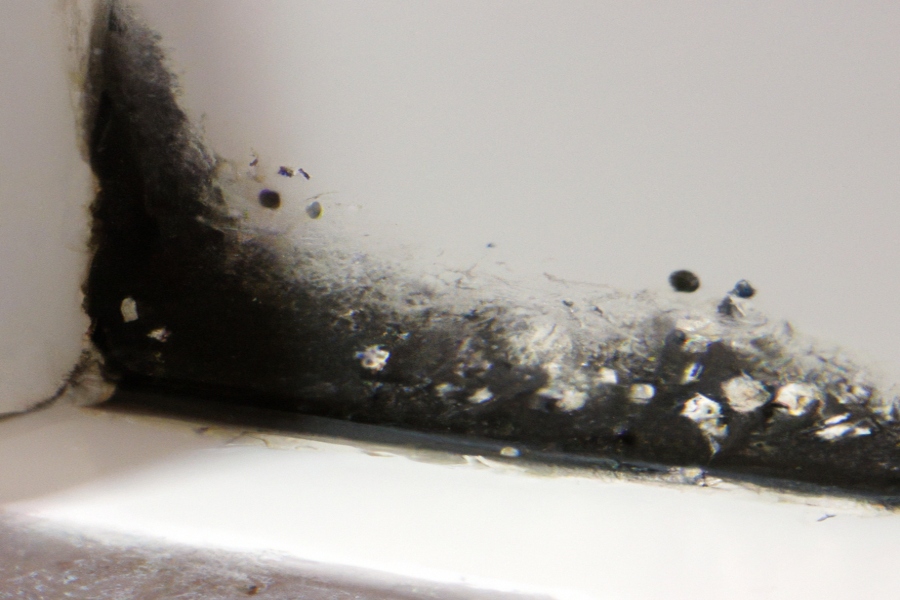Damp and mould are becoming increasingly common problems in many homes, especially during colder months when the air is more humid.
This has only been worsened by the cost of living crisis, which has left many households unable to keep their homes warm, meaning that damp and mould has been able to thrive.
This is concerning, as black mould, in particular, can be dangerous and cause health problems after prolonged exposure.
Therefore it is highly important to know if you have damp & mould, what causes it, and how you can get rid of it.
See below for some of our top tips:
What Causes Damp & Mould?
Damp and mould can occur in any property, but understanding the underlying causes is the first step to prevention. Here are some of the most common causes of dampness and mould growth:
- Cold & Condensation: Cold temperatures are one of the biggest contributors to the growth of mould in the home. When the temperature drops, walls, and surfaces in the home become cooler, which can create condensation and increase the risk of dampness and mould growth.
- Leaks: Leaking pipes or roofs can cause moisture to penetrate walls and floors, leading to dampness and mould growth.
- Rising damp: Rising damp occurs when moisture from the ground seeps into the walls and floors of a home.
- Poor ventilation: Lack of adequate ventilation can trap moisture in the home and increase the risk of dampness and mould growth.
How To Prevent Damp & Mould
Here are some of the most effective steps that you can take to prevent damp and mould from growing in your home.
- Identify the Causes of Dampness – Before you can treat the dampness & mould, you need to identify what is causing it. Check your home for leaking pipes, blocked ventilation or excessively cold surfaces that would be susceptible to condensation. Once you’ve identified the cause, you can take steps to address the issue.
- Address Mould Quickly -If you do notice mould growth in your home, it’s important to address it quickly. Leaving it to long can make the problem harder to treat.
- Improve Ventilation – If you feel that stale air may be the cause of your mould problem, then one of the best solutions is to improve ventilation. If the weather allows, then open your windows & doors regularly to allow a clear flow of air. Also, check any vents in the room and ensure that they are not blocked either internally or externally so that air can easily move in and out. If the room does not have vents then we would recommend looking into getting them fitted, either into the walls or on the windows. If the mould is within a bathroom or kitchen, ensure you use the extractor fan when cooking, or if someone is using the bath/shower. A dehumidifier can also be used as a temporary solution to remove moisture from the air. Finally, don’t forget to consider your cupboards and wardrobes too, as mould can form in there if they don’t have sufficient airflow – open the doors regularly to allow the air to move in and out.
- Insulate Your Home – As mentioned above, a lot of mould-related issues can be put down to your home being to cold. Insulating your home can help prevent dampness by keeping the walls and floors warmer. This reduces the likelihood of condensation forming, meaning mould is less likely to grow. Insulating your home can also save you over £690 per year on your heating bills, which will also help to keep your home comfortable and damp-free.
- Repair Leaks – If you have leaking pipes or rising dampness, it’s important to address these issues as soon as possible. Repair any leaks and treat rising dampness to prevent moisture from entering your home.
- Clean and Dry Your Home Regularly – Regular cleaning and drying of your home can help prevent dampness and mould growth. Use a damp cloth to wipe down surfaces, and ensure that any spills or leaks are cleaned up promptly. If you have access to a fungicidal wash or mouldicide then these can be used to help clean the issue too. Once removed then a fungicidal paint can be used on the walls to try and prevent any returns. It’s also recommended to clean anything that has been in a room with problematic mould – this includes shampooing carpets and dry cleaning mildewed clothes.
Mould can be tricky to deal with, however by following these tips and best practices, you can keep significantly reduce your chances of getting mould growth in your house. Prevention is key, but if you do notice any signs of dampness or mould growth, it’s important to take action promptly to prevent it from spreading and causing health problems.
Here at Westville, our friendly team has been advising home owners on how to deal with mould issues for years, so if you have any questions, or would like to know more about insulation for reducing mould problems, then please do send us a message using the form below and we will be happy to help.

